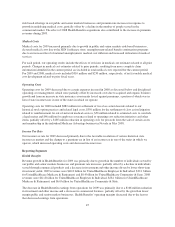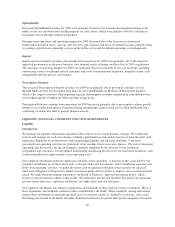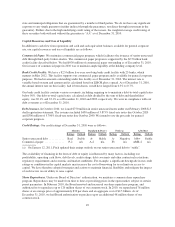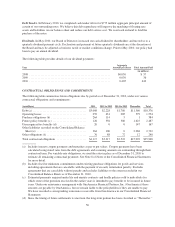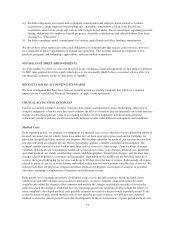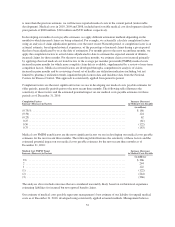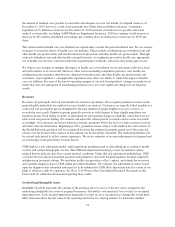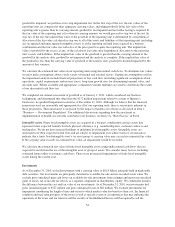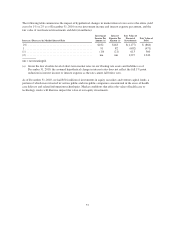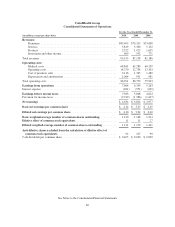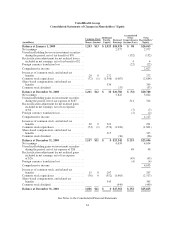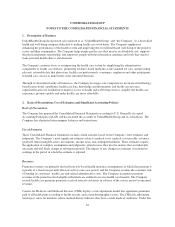United Healthcare 2010 Annual Report Download - page 57
Download and view the complete annual report
Please find page 57 of the 2010 United Healthcare annual report below. You can navigate through the pages in the report by either clicking on the pages listed below, or by using the keyword search tool below to find specific information within the annual report.security before recovery of the entire amortized cost. For debt securities, if we intend to either sell or determine that
we will be more likely than not be required to sell a debt security before recovery of the entire amortized cost basis
or maturity of the debt security, we recognize the entire impairment in earnings. If we do not intend to sell the debt
security and we determine that we will not be more likely than not be required to sell the debt security but we do not
expect to recover the entire amortized cost basis, the impairment is bifurcated into the amount attributed to the
credit loss, which is recognized in earnings, and all other causes, which are recognized in other comprehensive
income. For equity securities, we recognize impairments in other comprehensive income if we expect to hold the
equity security until fair value increases to at least the equity security’s cost basis and we expect that increase in fair
value to occur in a reasonably forecasted period. If we intend to sell the equity security or if we believe that
recovery of fair value to cost will not occur in the near term, we recognize the impairment in net earnings. New
information and the passage of time can change these judgments. We manage our investment portfolio to limit our
exposure to any one issuer or market sector, and largely limit our investments to U.S. government and agency
securities; state and municipal securities; mortgage-backed securities; and corporate debt obligations, substantially
all of investment grade quality. Securities downgraded below policy minimums after purchase will be disposed of in
accordance with the investment policy.
Income Taxes
Our provision for income taxes, deferred tax assets and liabilities, and uncertain tax positions reflect our
assessment of estimated future taxes to be paid on items in the consolidated financial statements. Deferred
income taxes arise from temporary differences between financial reporting and tax reporting bases of assets and
liabilities, as well as net operating loss and tax credit carryforwards for tax purposes.
We have established a net valuation allowance against certain deferred tax assets for which the ultimate
realization of future benefits is uncertain. After application of the valuation allowances, we anticipate that no
limitations will apply with respect to utilization of any of the other net deferred income tax assets. We believe
that our estimates for the valuation allowances against deferred tax assets and tax contingency reserves are
appropriate based on current facts and circumstances.
According to U.S. Generally Accepted Accounting Principles (GAAP), a tax benefit from an uncertain tax
position may be recognized when it is more likely than not that the position will be sustained upon examination,
including resolutions of any related appeals or litigation processes, based on the technical merits.
We have established an estimated liability for federal, state and non-U.S. income tax exposures that arise and
meet the criteria for accrual under U.S. GAAP. We prepare and file tax returns based on our interpretation of tax
laws and regulations and record estimates based on these judgments and interpretations. In the normal course of
business, our tax returns are subject to examination by various taxing authorities. Such examinations may result
in future tax and interest assessments by these taxing authorities. Inherent uncertainties exist in estimates of tax
contingencies due to changes in tax law resulting from legislation, regulation and/or as concluded through the
various jurisdictions’ tax court systems.
The significant assumptions and estimates described above are important contributors to our ultimate effective
tax rate in each year. A hypothetical increase or decrease in our effective tax rate by 1% on our 2010 earnings
before income taxes would have caused the provision for income taxes to change by $74 million.
Contingent Liabilities
Because of the nature of our businesses, we are routinely involved in various disputes, legal proceedings and
governmental audits and investigations. We record liabilities for our estimates of the probable costs resulting
from these matters. Our estimates are developed in consultation with outside legal counsel, if appropriate, and are
based upon an analysis of potential results, assuming a combination of litigation and settlement strategies and
considering our insurance coverage, if any, for such matters. It is possible that future results of operations for any
particular quarterly or annual period could be materially affected by changes in our estimates or assumptions.
55


